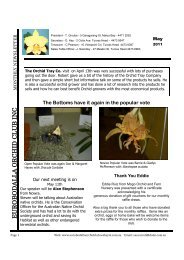Orchid Growing Substrates
Orchid Growing Substrates
Orchid Growing Substrates
Create successful ePaper yourself
Turn your PDF publications into a flip-book with our unique Google optimized e-Paper software.
older roots. The new roots that are formed in the new potting mix should help the plant to restart.<br />
However, for some plants it cannot be done without a great setback to them, especially the<br />
odontoglossum and miltoniopsis, which can be killed in the process, or severely stunted. The whole<br />
root system was acclimatized to very wet conditions, and is not hardened enough to survive in a drier<br />
potting mix, or even with pathogens, fungus, bacteria around, so it will die. Usually, when a sympodial<br />
plant loses all of its roots, like an odontoglossum, the older rootless bulbs and growths will die, as the<br />
new growth will make roots for itself, can sustain in part the older bulbs, but not completely. When<br />
some of the older bulbs die, they can start to rot, generate acidity, which greatly helps pathogens<br />
entering the new growth, which means a total plant collapse.<br />
- On a medical point, there are some unclear points, even as of today. Maybe we do not have the<br />
required knowledge to understand, but so far several countries charge a premium for Rockwool<br />
disposal, as a toxic waste. , the dusty thorny Rockwool with residues of some years of phytosanitary<br />
chemicals do not seem to be good for the environment. On to two other points, it has been claimed<br />
by some manufacturers that first, Rockwool, unlike asbestos, even if it will target, and successfully<br />
reach the same location in the lungs will ‘dissolve’ in the lungs by the ‘acidity’. On the other side, it is<br />
not dissolved by hydrochloric acid, at least it is only partially dissolved, with a residue. It is hard to<br />
understand where the solid residues from such a magic ‘dissolution’ would end up in the core of the<br />
lungs, if they would be teleported like in Star Trek out of the human body, or encysted, or whatever?<br />
The second point, some years ago Rockwool showed unacceptable levels of arsenic, lead and<br />
mercury. Again, it has been claimed at that time that the strong alkaline reaction of Rockwool<br />
prevented their assimilation and uptake by food crops on Rockwool slabs. However, plants do<br />
generate organic acids at their roots, the feeding solution is acid, and there would be a lot of<br />
microorganisms that can do a lot of funny to some compounds.<br />
Lava rock, aggregate, stones, perlite<br />
Lava Rock Pumice Perlite<br />
- A lot of recipes call for various types of stones, pumice, red lava rock, clay aggregates, seramis, perlite,<br />
gravel. However, depending on their sources, the results can be really different, and their chemistry<br />
makes them non inert. I suspected for years that growers using red Lava rock got some micronutrients<br />
out of it, and apparently it is the case. Some lava rock sources have a very high content of iron,<br />
manganese, eventually even potassium. It depends on the volcano, and even on the particular<br />
eruption. Without entering in a lot of details about geological matters, this kind of stones and<br />
aggregate materials have a wide range of application. However, there are some things that are little<br />
known from the users. First, pumice is one of the best stones available out of the whole series. It has a<br />
grey color, and can be calibrated to a uniform size. Some types can be partially or totally hygroscopic,<br />
retaining easily water, whilst providing good drainage. However, most serious traders of pumice have<br />
to either extract it from permafrost areas, or areas with an extremely cold winter. The reasons lie in<br />
the fact that some sources have been found to be very heavily contaminated by pathogenic<br />
nematodes. Nevertheless, for all those stones, including the processed perlite, the salts concentration<br />
must be assessed, and this needs to be done in two ways. Some pumice as an example floats for the<br />
first few days when dropped in a water bucket. Then, suddenly, after one or two weeks, they will<br />
absorb a lot of water, be saturated and drop at the bottom. If one tests the pumice water extract the<br />
Xavier Garreau de Loubresse<br />
8
















